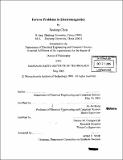Inverse problems in electromagnetics
Author(s)
Chen, Xudong, 1977-
DownloadFull printable version (12.99Mb)
Other Contributors
Massachusetts Institute of Technology. Dept. of Electrical Engineering and Computer Science.
Advisor
Jin Au Kong and Tomasz M. Grzegorczyk.
Terms of use
Metadata
Show full item recordAbstract
Two inverse problems in electromagnetics are investigated in this thesis. The first is the retrieval of the effective constitutive parameters of metamaterials from the measurement of the reflection and the transmission coefficients. A robust method is proposed for the retrieval of metamaterials as isotropic media, and four improvements over the existing methods make the retrieval results more stable. Next, a new scheme is presented for the retrieval of a specific bianisotropic metamaterial that consists of split-ring resonators, which signifies that the cross polarization terms of the metamaterial are quantitatively investigated for the first time. Finally, an optimization approach is designed to achieve the retrieval of general bianisotropic media with 72 unknown parameters. The hybrid algorithm combining the differential evolution (DE) algorithm and the simplex method steadily converges to the exact solution. The second inverse problem deals with the detection and the classification of buried metallic objects using electromagnetic induction (EMI). Both the exciting and the induced magnetic fields are expanded as a linear combination of basic modes in the spheroidal coordinate system. Due to the orthogonality and the completeness of the spheroidal basic modes, the scattering coefficients are uniquely determined and are characteristics of the object. (cont.) The scattering coefficients are retrieved from the knowledge of the induced fields, where both synthetic and measurement data are used. The ill-conditioning issue is dealt with by mode truncation and Tikhonov regularization technique. Stored in a library, the scattering coefficients can produce fast forward models for use in pattern matching. In addition, they can be used to train support vector machine (SVM) to sort objects into generic classes.
Description
Thesis (Ph. D.)--Massachusetts Institute of Technology, Dept. of Electrical Engineering and Computer Science, 2005. Vita. Includes bibliographical references (p. 155-164).
Date issued
2005Department
Massachusetts Institute of Technology. Department of Electrical Engineering and Computer SciencePublisher
Massachusetts Institute of Technology
Keywords
Electrical Engineering and Computer Science.